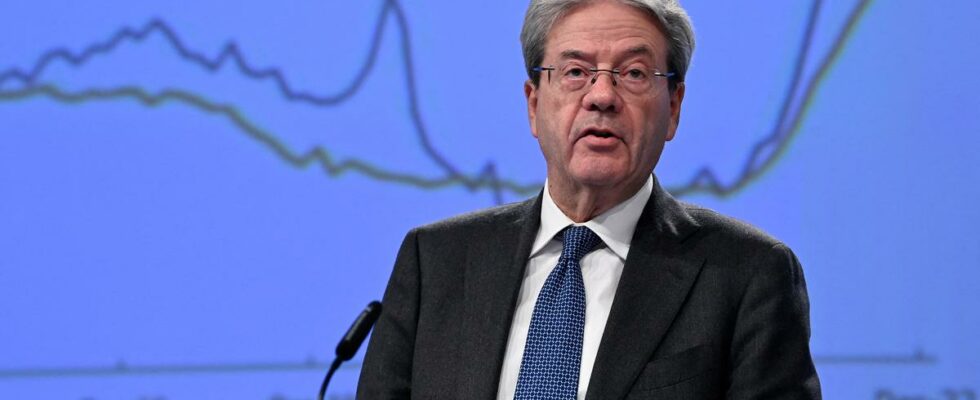The new forecasts from Brussels are better than in the fall thanks to the fall in the price of gas.
Correspondent in Brussels
Despite the war in Ukraine, the European Union should escape recession in extremis. This is the scenario favored by the Commission in its winter economic forecasts published on Monday.
Growth should thus reach 0.8% this year, ie 0.5 points more than forecast in the autumn. For the countries of the euro zone, there is talk of an increase in GDP of 0.9%, or 0.6 points better. Next year, in 2024, growth would stand at 1.6% in the EU and 1.5% in the euro zone, unchanged from the autumn forecast.
Read alsoThe surprising resistance of the European Union to the economic crisis
The European economy owes its salvation to a better than expected year 2022, with a growth rate of 3.5%, instead of 3.2% expected. She “has entered 2023 on a healthier footing than expected and looks poised to escape recession”summarized the Commissioner for the Economy Paolo Gentiloni, speaking of a “remarkable vigor”.
In detail, only Sweden would see its economy seize up in 2023, with a GDP down 0.8%. “It should be noted that the Swedish economy had shrunk relatively little in 2020, by only 2.2%, and rebounded strongly in 2021, by 5.1%”however reassured Paolo Gentiloni.
This year as in 2024, France should do better than Germany, with growth forecasts of 0.6% then 1.4 against 0.2% and 1.3%. However, the two major EU economies will be below the European average. Spain is thus doing very well. Thanks to the strong recovery in tourism, its economy should experience growth of 1.4% in 2023 then 2% in 2024. As for the Italian economy, it could grow 0.8% this year then 1% next year, driven by the European recovery plan of which it is the main beneficiary.
Paolo Gentiloni offers several explanations for these more positive than expected forecasts. First and foremost, the noticeable drop in gas prices. After the historic surge it experienced in the summer of 2022, the TTF, the benchmark index for the EU, returned at the end of January to its pre-war levels in Ukraine, i.e. 55 euros per MWh. A drop which is partly explained by milder temperatures, but also by greater sobriety among Europeans. ” Looking back, the resilience of EU households and businesses is impressive. From January to November 2022, natural gas consumption in the EU has been consistently below the 2017-2021 average, with consumption in October and November being 25% below the 2017-2021 average, exceeding the target for reduction agreed at EU level”welcomes the commissioner.
Another reason for satisfaction, the EU currently has high reserves, with storage 66% full. A level never reached at this time of year. Added to this is the gradual recovery of the Chinese economy. As a result, fewer breaks in supply chains.
Persistent Headwinds
However, the Commission remains extremely cautious about “strong headwinds”including high uncertainty about the evolution of the war in Ukraine and “wider geopolitical tensions”.“Better than expected doesn’t mean good”, Gentiloni also warned. Thus, consumers and businesses will have to continue to deal with gas prices three times higher than in 2019 and underlying inflation (inflation excluding energy and unprocessed food products) still on the rise in January.
Read alsoInflation: this bill which could reinforce the rise in prices in supermarkets
“With inflationary pressures persisting, monetary tightening is likely to continue, weighing on business activity and dampening investment”, underlines the European executive. The commission does not expect inflation to come down quickly. It would drop from 9.2% in 2022 to 5.6% in 2023 then 2.5% in 2024 in the euro zone. Prices should continue to rise more strongly this year in the east of the bloc, in countries that have not adopted the euro as their currency.
An energy shield of nearly 700 billion euros
Faced with the surge in oil, gas and electricity prices that began in the fall of 2021, European states deployed what were called in France, energy shields, in order to protect businesses and households. . The expenditure of the governments of the Twenty-Seven amounts, according to the latest calculation of the Bruegel think tank, to 681 billion euros. Germany, the leading power in the European Union, is carving out, unsurprisingly,
the lion’s share, but in impressive proportions: it announced support of 268 billion euros. France, again according to Bruegel’s estimate, has committed 92 billion euros. Or 3.7% of its GDP, compared to massive support from the Germans of 7.5% of annual GDP. Note, the experts take into account the measures announced, which does not mean that the entire envelope has been disbursed. The German plan of 200 billion euros which had drawn criticism from other Member States, fearing unfair competition, is far from having been fully disbursed. In relation to GDP, it is Slovakia which provided the largest public effort, at 9.3%.
SEE ALSO – The National Ballet of Ukraine in Paris
